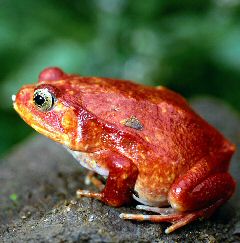Top Stories
Downtown falcon chicks' deaths linked to bacteria
Seattle Times – seattletimes.nwssource.com
08 Jul 2008
S Doughton
Location: Seattle, Washington, USA – Map It
A bacterial infection killed the baby peregrine falcons that hatched atop the Washington Mutual Tower in downtown Seattle during the spring.
Scientists at the Washington Animal Disease Diagnostic Laboratory at Washington State University performed a necropsy on two of the three young birds and found their brains had been attacked by a type of bacteria called mycoplasma, said veterinarian Lindsay Oaks, the lab's head of microbiology.
 Farmlands Too Toxic For Amphibians
Farmlands Too Toxic For AmphibiansScience a Go Go – www.scienceagogo.com
07 Jul 2008
K Melville
University of Florida (UF) zoologists have found that toads in busy suburban areas are less likely to suffer from reproductive system abnormalities than toads near farms - where some of the amphibians they examined had both testes and ovaries.
The new study is likely to have wide implications for the longstanding debate over whether agricultural chemicals pose a threat to amphibians, with UF researcher Lou Guillette noting that; "as you increase agriculture you have an increasing number of abnormalities."
Cited Journal Article
Agriculture Alters Gonadal Form and Function in the toad Bufo marinus. Environ Health Perspect. 2008 Jul: Epub ahead of print [online abstract only] - KA McCoy et al.
Other Frog News
Wildlife jeopardized by Ottawa's inaction, group says
CBC News – www.cbc.ca
08 Jul 2008
The federal government has failed to protect deer and bison from the spread of chronic wasting disease and tuberculosis, the head of a Saskatoon-based wildlife health centre says. Ottawa has a national animal health strategy, hammered out about three years ago, that could keep disease that has plagued deer and bison populations in recent years in check, but it has never been implemented, Ted Leighton, the executive director of the Canadian Cooperative Wildlife Health Centre, told CBC News.
Under the strategy, Ottawa and the provinces agreed to a national surveillance program aimed at detecting diseases earlier and improving response, he said. But it has never been put into play, he said.
Warming could disrupt coral's sex
Science Alert – www.sciencealert.com
10 Jul 2008
Climate change may have major impacts on the reproduction of the world’s corals, by changing some of the cues which trigger corals to spawn.
This is one of the major issues being explored by the world’s leading coral scientists at the International Coral Research Symposium (ICRS) in Fort Lauderdale, Florida from 7 July - 11 July 2008.
It follows the recent discovery that the world’s biggest orgasm – the synchronized mass-spawning of corals on major reef systems – may in fact be far more widespread than previously thought, to the point of being almost global.
The Good, the Bad, and the Smelly: USGS at the 2008 Coral Reef Symposium [USGS press release]
Tests Show No Evidence That Whirling Disease Is Spreading In Maryland
Maryland Dept. of Natural Resources – www.dnr.state.md.us
08 Jul 2008
Department of Natural Resources officials are continuing to monitor sites throughout the state for evidence of whirling disease, a parasitic infection that attacks trout. Results from recent tests found no evidence the disease is spreading.
OTHER WILDLIFE HEALTH RELATED NEWS
- Pandemic Mutations In Bird Flu Revealed
- Mystery disease also hitting NH bats
- Promoting coexistence of people and wildlife
- Climate change: disease spread fears
- Tuberculosis May Have Migrated From Humans To Cattle, Not The Reverse
- Study Shows Rise In Cornwall's Dolphin, Whale, And Porpoise Deaths
- West Nile Virus Activity --- United States, 2007 [CDC MMWR report includes map]
- The way to a virus' 'heart' is through its enzymes [bluetongue virus]
- Severe Droughts Trigger Disease, Lion Die-Offs [audio broadcast available]
WILDLIFE HEALTH RELATED PUBLICATIONS
Viral infections in wild-living European wildcats in Slovenia
European Journal of Wildlife Research. 2008; Epub ahead of print
J Racnik et al.
CHIMIA International Journal for Chemistry – 2008 May: 62(5)
In this issue - NRP: Endochrine Disruptors






No comments:
Post a Comment